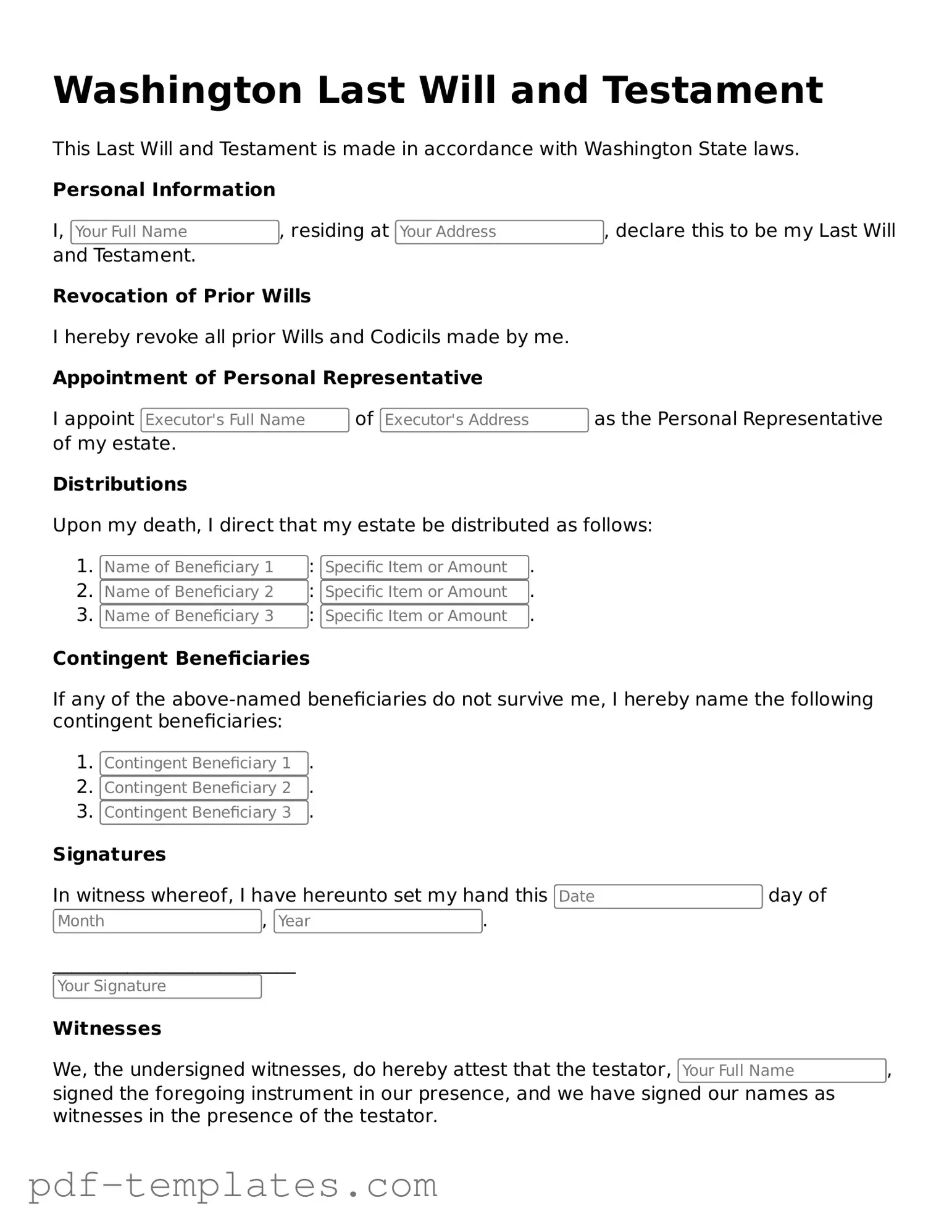The Washington Living Will is similar to the Last Will and Testament in that both documents express an individual's wishes regarding their life and property. While a Last Will and Testament details how assets should be distributed after death, a Living Will focuses on medical decisions and end-of-life care. Both documents require clear language and the signature of the individual to be legally binding, ensuring that their intentions are respected in both health and financial matters.
The Washington Durable Power of Attorney is another document that shares similarities with a Last Will and Testament. Both documents allow individuals to designate someone to make decisions on their behalf. However, a Durable Power of Attorney is effective during the individual’s lifetime and can cover financial and healthcare decisions, whereas a Last Will and Testament only takes effect after death. Each document serves to protect the individual's interests and ensure that their wishes are carried out.
A Revocable Living Trust is comparable to a Last Will and Testament in its purpose of asset distribution. Both documents are used to manage and transfer property upon death. However, a Revocable Living Trust can avoid probate, allowing for a more private and often quicker transfer of assets. Unlike a Last Will, which becomes public record, a trust remains confidential, offering additional privacy for the individual's estate plan.
The Washington Advance Directive combines elements of both a Living Will and a Durable Power of Attorney for healthcare. Similar to a Last Will and Testament, it allows individuals to express their healthcare preferences and appoint someone to make medical decisions if they become incapacitated. This document ensures that an individual’s healthcare wishes are honored, paralleling the intent of a Last Will to ensure that one's wishes regarding property and dependents are respected after death.
The Washington Declaration of Guardian is another document that is similar to a Last Will and Testament, particularly in its focus on personal care. This document allows individuals to designate a guardian for their minor children or dependents in the event of their death or incapacitation. While a Last Will primarily addresses asset distribution, both documents reflect an individual’s desire to provide for their loved ones and ensure their well-being.
The Washington Beneficiary Designation form is related to a Last Will and Testament in that both documents determine how assets are distributed. Beneficiary designations are often used for specific accounts, such as life insurance or retirement accounts, and take precedence over a Last Will. This means that individuals can directly name beneficiaries, ensuring that certain assets bypass the probate process, similar to how a Last Will directs the distribution of an estate.
The Washington Codicil serves as an amendment to an existing Last Will and Testament. It allows individuals to make changes or updates to their will without drafting an entirely new document. This is similar to a Last Will in that it must be signed and witnessed to be valid. A Codicil is a useful tool for adapting an estate plan as circumstances change, while still maintaining the original intent of the Last Will.
The Washington Affidavit of Heirship is another document that can complement a Last Will and Testament. It is used to establish the rightful heirs of a deceased person when there is no will. While a Last Will clearly outlines the distribution of assets, an Affidavit of Heirship can help clarify the legal heirs and their respective shares, thus assisting in the proper administration of the estate.
The Washington Estate Inventory is similar to a Last Will and Testament in that it provides a detailed account of an individual's assets. This document is often created as part of the probate process to help ensure that all assets are accounted for and distributed according to the wishes expressed in the Last Will. Both documents work together to provide clarity and transparency regarding an individual's estate.
In California, the rental application process is a crucial step for landlords seeking responsible tenants. Utilizing a thorough application form is essential for gathering key details about applicants, including their financial background and rental history, ensuring landlords make informed decisions. For those interested in accessing various necessary documents, including the California Rental Application, resources can be found at All California Forms, which provides guidance and templates tailored to the state's regulations.
Lastly, the Washington Trust Certification is akin to a Last Will and Testament in its function of confirming the existence and terms of a trust. This document can be used to show that a trust is valid and to outline its provisions. While a Last Will distributes assets upon death, a Trust Certification can facilitate the management and distribution of assets during the individual's lifetime and beyond, ensuring that their wishes are upheld.
